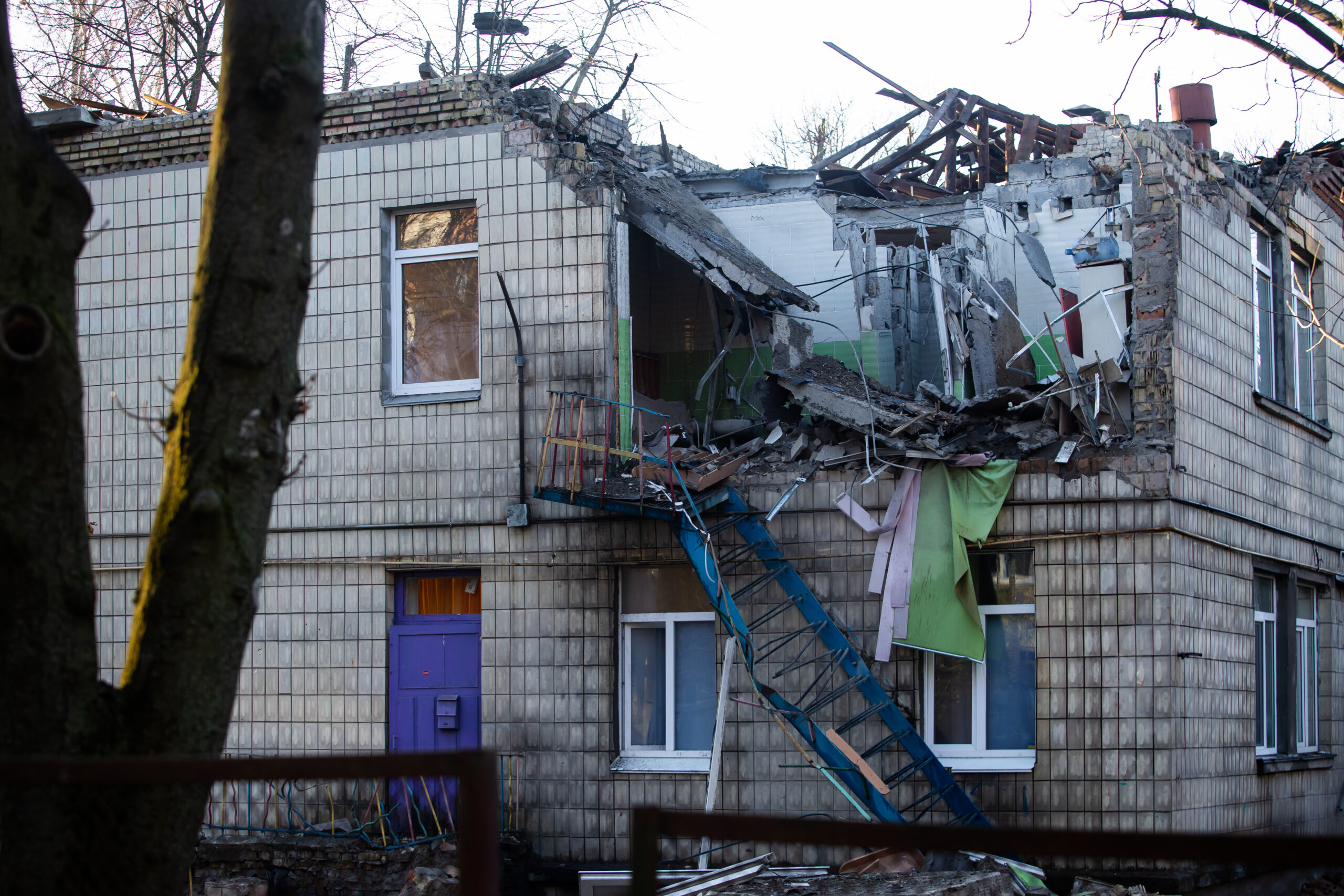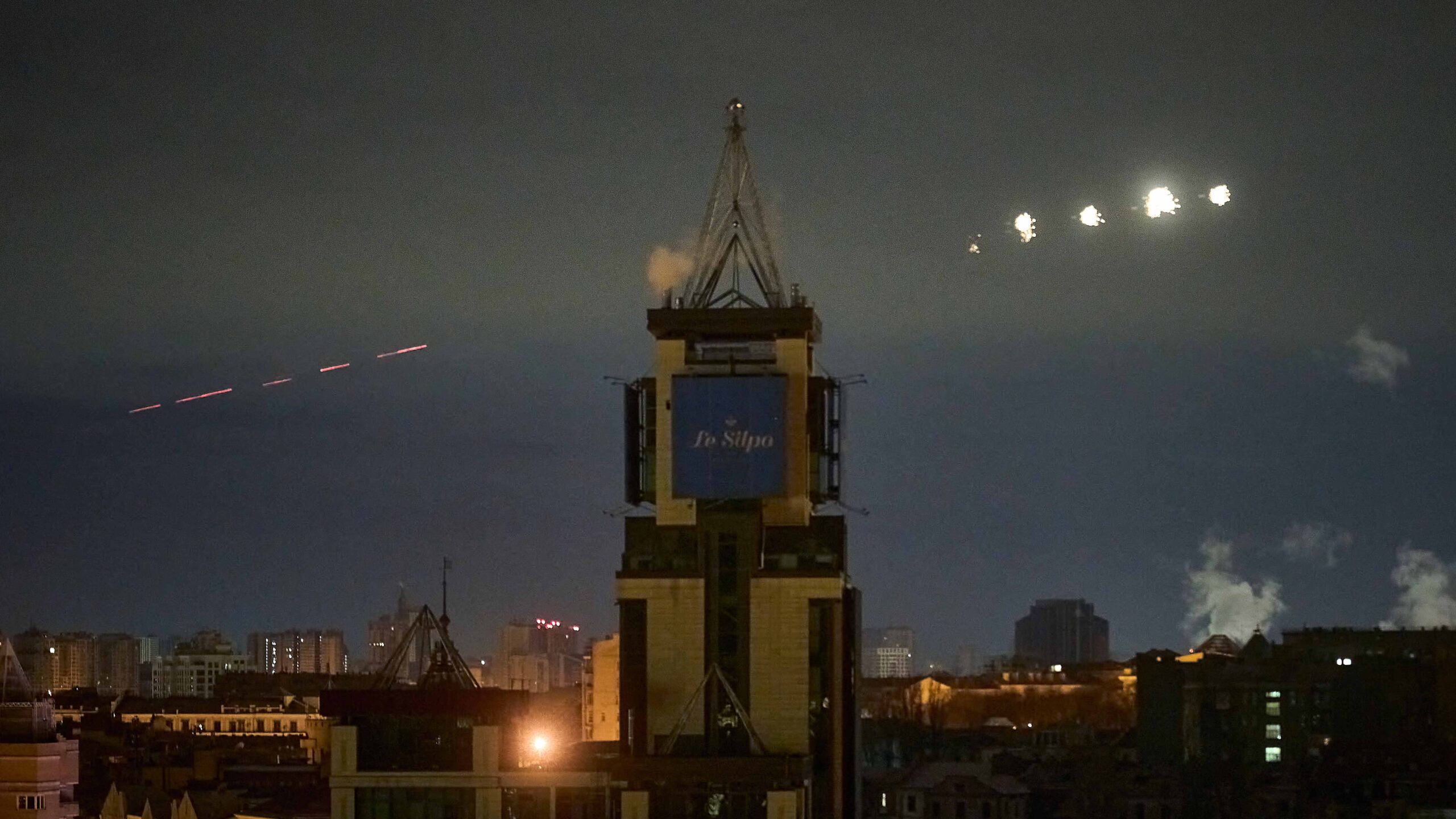Russia overnight launched what Ukrainian officials describe as the largest drone attack on their country so far, with 75 one-way attack drones being launched, mainly against the capital, Kyiv, and the surrounding region. The drone assault has been seen as the opening salvo in Russia’s expected winter campaign attacking Ukrainian energy infrastructure, to inflict maximum disruption on its civilian population as the winter weather begins to bite.
According to the Ukrainian Air Force, the 75 drones mainly targeted different districts of Kyiv, where the first of them arrived in the early hours of Saturday. Further waves appeared over the capital around dawn. In all, the air raid warning in Kyiv lasted six hours.
Ukrainian officials say that five people were wounded by the drone strikes in Kyiv, although that number could still rise. So far, there have been no reports of fatalities.

Writing on the Telegram messaging app, Kyiv mayor Vitali Klitschko said that among those injured was an 11-year-old girl. He also said that buildings had been damaged in different districts of the capital, while fragments from a drone that was shot down started a fire in a children’s nursery.

After the overnight attack, the Ukrainian energy ministry said that nearly 200 buildings in Kyiv, including 77 residential ones, had been left without power.
In its first assessment of the raid, the Ukrainian Air Force claims that 71 of the 75 drones were successfully brought down, later revising the number of downed drones to 74. Of those, 66 are said to have been brought down over Kyiv and the surrounding region.
“Anti-aircraft missile troops, tactical aviation, mobile fire groups, and electronic warfare units were involved in repelling the air attack,” said the Air Force. It added that a Kh-59 series standoff air-to-surface missile was also destroyed in the Dnipropetrovsk region.
The Ukrainian Air Force said that the Shahed-type drones used by Russia were “launched from two directions — Primorsko-Akhtarsk and the Kursk region, Russia.”
Outside of Kyiv and its environs, there are reports that Russia also targeted the Sumy, Zaporizhzhia, Mykolaiv, and Kirovohrad regions overnight.
Meanwhile, at least some of the drones used in these latest attacks were painted black, apparently to reduce their visual conspicuity and make them harder to detect when using searchlights at night. The paint could have some radar-absorbing qualities, as well, but that is not confirmed at this time. Interestingly, the latest jet-powered versions of the Shahed recently displayed in Iran also wore a matte black paint scheme, as you can see here.
In response to the reported success of Ukraine’s air defenses against this latest raid, Mykola Oleschuk, the chief of the Ukrainian Air Force, pointed to the effectiveness of mobile fire units, in particular. Oleschuk claimed that almost 40 percent of the drones downed last night were accounted for by these units.
Mobile fire units are typically formed of highly mobile pickup trucks fitted with a heavy machine gun or anti-aircraft cannon mounted on their flatbed.
Ukrainians — including President Volodymyr Zelensky — have noted that the drone attack came on the day that Ukraine commemorates the Holodomor, the famine in which several million mainly Ukrainian people starved to death during the Soviet era, in 1932-33.
Writing on Telegram, President Zelensky described the raid as “Willful terror … The Russian leadership is proud of the fact that it can kill.”
Whether the latest drone strike on the capital was timed to coincide with the day of remembrance for Holodomor is unclear, but the famine is a powerful symbol of Russian-Ukrainian tensions.
While Ukraine and over 30 other countries recognize Holodomor as a genocide of the Ukrainian people by the Soviet Union, Moscow doesn’t consider that the deaths were caused by a deliberate genocidal policy. Kremlin officials also point out that Russians and other ethnic groups also suffered because of famine.
Nevertheless, Ukraine frequently draws parallels between the treatment of its people under Soviet rule, and Russia’s more recent behavior, including the current invasion.
The apparent success of Ukraine’s air defenses in defeating the drone strikes may also be down to the fact that a campaign of this kind had been widely expected to start any time soon.
Ukraine has repeatedly issued warnings that Russia is planning to launch a renewed assault on its critical national infrastructure, and especially its energy grid now that winter is here. Similar tactics were also employed by Russia last year, leading to extensive damage and disruption.
“It looks like tonight we heard the overture. The prelude to the winter season,” Serhiy Fursa, a prominent Ukrainian economist, wrote on Facebook.
Thanks to its Iranian-designed kamikaze drones, Russia has a much cheaper means of keeping up a relentless assault on Ukrainian targets far beyond the front lines, compared to the ballistic missiles and cruise missiles that were used at the beginning of the campaign and more sporadically as time passed. There are reports that production of Shahed-type drones has now also begun in Russia, providing a more immediate source of these weapons.

Photo by YASUYOSHI CHIBA/AFP via Getty Images
Overall, the expanding use of the Shahed drones also reflects dwindling stockpiles of Russian long-range missiles. Furthermore, the production of new ballistic and cruise missiles in Russia continues to be hampered by stringent Western sanctions, with many of these weapons having made use of subcomponents of foreign origin.
Speaking to Ukrainian national television in October, Yuriy Ihnat, a spokesperson for the Ukrainian Air Force, said that attacks by Russian drones were expected to reach a record number this winter.
Even in September this year, the Ukrainian Air Force reported that more than 500 drones had been launched against Ukraine in that month, a new record in itself. By comparison, Russia used around 1,000 Shahed drones across a full sixth-month period last winter.
Even the smaller effort targeting the country’s energy infrastructure last year left millions of Ukrainians without power. Grid operators imposed regular rolling power cuts and rationing of hot water, while repairs to the energy infrastructure were ongoing as of last month.
As well as the more ad-hoc mobile fire units, Ukraine is also better prepared to defeat the drones this time around thanks to the receipt of more Western-made air defense equipment. While the capabilities of systems like the National Advanced Surface-to-Air Missile System (NASAMS) and the IRIS-T SLM are undoubted, especially against drones and cruise missiles, the numbers of these available fall short of being able to ensure coverage of all potential energy targets, let alone other critical infrastructure.
The demand for ground-based air defense systems also to be used to protect Ukrainian troops taking part in the counteroffensive in the east and south of the country piles more pressure upon the relatively limited number of Western air defense systems, as well as the older Soviet-era systems that make up the bulk of the Ukrainian air defense network. This is, to a large degree, why extemporized solutions, such as mobile fire units, have also been fielded.
There remains also a heavy mismatch between (especially the high-end) ground-based air defense systems used by Ukraine and the relatively cheap Shahed drones that are consuming air defense missile stocks at a prodigious rate. While one of these drones might cost in the region of tens of thousands of dollars, a single IRIS-T or AMRAAM missile round will have a price tag in the hundreds of thousands, at least. Indeed, the U.S. Air Force can expect to pay around $1 million for a single AIM-120C AMRAAM round.
The Ukrainian Air Force’s dwindling fleet of Soviet-era fighters is also less than ideally suited to tackling the slow and low-flying Russian drones, another reason why so many demands have been made to expedite the delivery of F-16 fighters promised to Kyiv. However, the most realistic estimates propose that it won’t be until next year, at the earliest, that Ukrainian F-16s take to the skies, while Ukrainian pilots aren’t expected to reach full combat proficiency in sufficient scale until 2027.
In the meantime, Ukrainian officials have continued to push for more Western ground-based air defense equipment. This was one of the priorities expressed by President Zelensky during his visit to Washington in September.
“Today there are important negotiations in Washington,” Zelensky said in a message on Telegram at the time of his visit. “Air defense for Ukraine is among the top issues. More air defense, more support for Ukrainian soldiers on the front lines.”
One of the results of this campaign has been the establishment of a new ground-based air defense coalition, led by France and Germany, designed to enhance Ukraine’s ability to defend against Russian missile and drone threats. The 20-nation coalition was announced earlier this week, although details are currently limited. Just ahead of the announcement, however, Germany pledged $1.4 billion in aid to Ukraine, including an unspecified number of additional IRIS-T air defense systems with interceptors and one more Patriot air defense system. You can read more about the wider initiative here.
Ukraine has clearly been making significant efforts to make itself more resilient against Russian drone attacks this winter. However, no air defense system is perfect and the challenges of protecting infrastructure across Europe’s largest country are obvious. At the same time, the conflict has so far shown that, while attrition may be high, mass drone strikes are always likely to cause at least some level of damage and destruction, and that they always have the potential to be deadly to the civilian population.
Contact the author: thomas@thedrive.com
